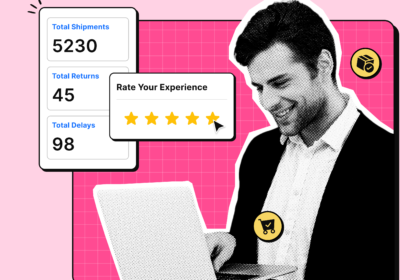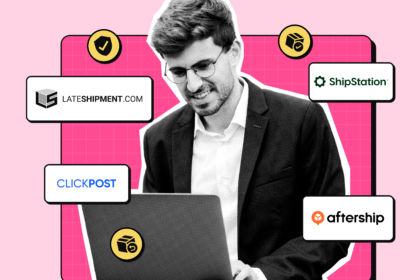Have you ever thought about the pioneers in e-commerce, the businesses who thought of e-commerce and kickstarted the model before all the current hype it has now?
Well, you don’t have to ponder over it and imagine, as we have one of the first e-commerce businesses ever to exist, narrating their story to the journey of success in this episode.
SportStop is an online sports store specializing in lacrosse goods for athletes. Started in 2001, this family-owned brand has adorned multiple accolades in its 20+ year-long online journey.
We spoke to the President of SportStop, Paul Dell, to know more about how they grew to become a differentiator in the lacrosse industry in the US, and what it means to be in e-commerce to make it big. Here’s what Paul had to say about it.
Hey Paul, It’s great connecting with you. Could you give us a brief introduction about yourself and we’d like to hear about the story of SportStop in your words?
We launched SportStop in 2001 with an online selling platform, it was actually my second e-commerce venture. I started my first online sporting goods auction site back in 1996.
Initially, we sold sporting goods for ten or so different sports, and over time, kept focusing down and eliminating categories of work.
So for the last ten years, we’ve mainly focused only on selling lacrosse, since that’s the area we had the most success in. Though we had the bandwidth to later expand to other sporting goods, we stayed focused on lacrosse since we wanted to stay a meaningful player in a smaller market and deliver value through our goods.
We do much of the stuff in the house, from fulfillment to customer support.
That’s really interesting to hear. You’ve been in the e-commerce space from a very early stage as you mentioned earlier. What prompted you to take on the digital world? How was the market back then?
My interest in sporting goods and sales started early on, given my father had a bicycle shop and I spent most of my summer holidays there.
By the time I was in college majoring in physics and math and going to computer school simultaneously, I witnessed the world adapting to the world wide web and the reception of the idea of the internet exploding. I mean I remember back when I downloaded the browser onto my Unix computer in the mid-90s when it was launched.
Eventually, I thought of selling my goods online and also managed to raise angel investment for it. But the problem with the auction website was that there might be a great deal for a customer once, maybe left-handed golf gloves or something, but then, once you acquire that customer and you sell them that thing, you’d end up not having anything of interest for them for weeks or even months.
So we were constantly acquiring new customers without actually providing them a second touchpoint of interest. We eventually ended up having to file bankruptcy for the business and never got to the second venture round. Because, because we scaled rapidly, to about 30 employees, we were making just a couple million dollars in sales.
SportStop was my second venture, launched in 2001, which addressed all the shortcomings of my initial venture. We ended up making the same profits for 1/10th of the acquisition cost of the auction site within three years.
I was still selling some things, but on other auction sites like Amazon and eBay. We also had our store. Over time it took over more and more of the business and thus we decided to focus on what really worked well- lacrosse.
That’s one of the most interesting stories in the world of e-commerce. Being in e-commerce for over 20 years, you’d have witnessed all the evolution of the internet and business online. What are some tips you’d give for people starting out in the E-commerce space?
My number one advice would be to get started. It’s easy and inexpensive to get started on something.
Open a little store, sell a few things, maybe just do it on the side while keeping your other day job for a while. But there are just so many options you can look into without needing a huge infrastructure anymore.
Get a 3rd party warehouse if your business handles big and bulky items, outsource customer support if you need it 24/7. You can do so much for so little nowadays to get started.
One thing even we as a business might have to put more effort into is in social media, be active, and get the right influences.
In case you’re someone looking to open a physical store, it’s really important to make a great online presence.
That's great advice. Having said that though, one of the elephants in the room, especially over the past year and a half has been COVID. One of the hardest-hit Industries has been the sporting goods space, as people were mandated to stay indoors. What were the strategies you had in place to survive that? And how effective were those?
We had the highest sales ever, just before COVID hit. The sales were up 10-20% and things were looking great.
When COVID hit, the sales dropped about 90%; and then we had a flooded return. It was pretty dramatic. I still remember it was a Wednesday when our sales abruptly tanked. We ended up laying off half our staff. The rest of us took pay cuts to cut costs as much as possible. We cut back on everything.
Eventually, sales recovered, since everybody was stuck at home, there was a bit of a sales bump in some of the things that people could do at home, like a goal in your backyard or a rebounder and things like that.
Meanwhile, we rethought all our processes to accommodate this change.
We switched to Shopify, we also switched off our back-end system, our accounting system, we changed everything to new systems that both function better and cost less than what we were doing before. Today we’re more efficient, we’re able to do more with fewer people, and the technology costs half of what it used to.
Also read: Enhance Holiday Post-Purchase Experience with Existing Tools
We were asking our readers what they’d want to hear from you, and one of the things that came up was your positioning. How did you narrow down on a niche area like lacrosse? And what were the parameters that led you to focus specifically on this market?
Basically, finding out the best product-market fit for you is the answer.
What worked the best for us was trial and error. I initially launched the site, tried 10 to 12 different sports products, and kept narrowing it down to what worked best for us.
We also tried to build up and do more, but things were either declining in sales or not growing fast enough, so we ended up eliminating them.
For example, before going exclusively to lacrosse, we did focus on snowboarding. So snowboarding, you know, we also sell snowboards. But everything from shipping, setting up the warehouse, to dealing with vendors were entirely different from selling lacrosse.
Thus, though it gave us 20% of our overall business, it was only right to increase our knowledge and range by focusing on lacrosse goods. Focus on the stuff that’s working, and make that better and better.
Sporting goods happens to be one of the hardest industries to be in, especially when you're online as athletes can be particular about what they want. How are you able to offer a great customer experience on the website, and make sure they stick with the decision to purchase equipment online?
Firstly, our return rates are lower than the average online sporting goods businesses because people are a little bit more knowledgeable about what the product is, and what it’s gonna be like. The only factor returns boils down to is the sizing issue, but that’s expected.
Being responsive to customer queries cuts all the loose ends in general. When a customer says “Oh, I thought I was getting this, but I got that”, it all boils down to how you respond to such customers as a business
We once also faced discrepancies in sizing charts that the brand sent us to what the products were actually sized. We mentioned that on our website to avoid customer confusion. This is one major differentiator between shopping at big marketplaces like Amazon.
The customer support team there might not know about any products they sell and the only solution they’d provide might be to return the product. That’s one benefit of being a niche player online for us.
Most importantly, make it easy to buy, return, and use your e-commerce website in general.
Something we’ve consistently heard about when you're doing background research is that people speak very highly of the customer experience they received. What should the brands start out doing to get the customer experience right?
Attending to people on time and providing clear ways for people to communicate. For example, if you’re going to have online chat support, have it live for a reasonable number of hours and promptly respond during that window. This would set the right expectations for your customers and also help your business be efficient.
People could still contact you through email during the rest period if it’s an emergency. Making sure all your touchpoints are reasonably responsive in such cases and not leave customers feeling like they’re screaming into the void would work wonders.
Listening enough to what that question is to really answer the question they’re asking and not assuming you know also makes a ton of difference and saves both your time and the customers’.
I sometimes skim through our support tickets just to see how things are and more than once I’ve been in situations where I’ve felt “you didn’t really answer the question they asked”.
People also tend to have more than one question. You’ve got to take a moment to prioritize their asks and address all of them.
Oftentimes, support teams keep getting the same question and end up assuming the fourth person dealing with the same products as the previous ones would have the same queries too. In such cases, we need to focus on listening to customers’ queries and addressing them.
In some cases, tickets might take weeks to be resolved and have external dependencies. Being consistently responsive is also a crucial factor in providing a good customer experience. Follow up when you promised to, and keep tabs on new queries at the same time.
Investing in a good help desk would be a great option to keep up your service in such cases.
Those are simple but effective pointers!
We make sure to get the basics right and stay true to the ground. Do the basics and do them right, and keep doing it day after day after day and be super reliable.
There have been days we’ve been out there with headlamps, picking products out of the warehouse, and running extension cords, tethering the internet with our cell phone if the internet’s down, and making things work.
With such an emphasis on getting basics, I think a perfect follow-up question to that is we are approaching the busiest part of the year for businesses - the holiday season; where not only names go up, but the associated issues like delivery delays, shipping delays also creep up. What is your strategy for planning and executing things?
We try to prepare and plan a lot, and get our inexperienced staff prepped up with basics and what to expect.
The second thing is to make sure we have all the required supplies in check. Do we have all the boxes we need? Is all the equipment working? Is the whole team equipped with their assigned responsibilities? Do we have enough paper for the printers? Do we have enough tape? Do we have enough labels? Do we have enough stationary guns, etc.,
Keep a checklist of miscellaneous items like iPads and scanners. Make sure everything’s numbered and everything’s in a location with a barcode.
Make sure all minor hindrances that occur once or twice a month, restricting your productivity get addressed prior as it’s too risky to take chances during the busiest part of the year.
We also, at times, hire for the holiday rush, and we have a clear-cut process for such holiday hires and a training program in place.
One final question to round up. Tell us about how you found out about Lateshipment.com
I remember finding it on the Shopify app store, I was using another tracking software with a lot of features that were not useful for me and was looking for a better product. I wanted to be able to automate filing for claims and provide a better experience for my customers where they can track their orders and see what’s going on.
Since we’ve started using it, we found even more easter eggs like offbeat notifications on shipping status like delivery delays, and delivery failures. Before that, we were playing the catch-up game where the customer would raise a support ticket and we’d respond. Now it’s all proactive and automated, making our overall CX better.
That’s why I’m currently excited about your returns management suite. I can see how beneficial it would be for our business if we could track and support through our returns process and have visibility in that phase.
Thank you so much, Paul, again, it’s been a pleasure working with you. And at the same time, looking at the larger picture that we had, especially coming from somebody who has such rich experience in the E-commerce space.
I’m sure it’s going to benefit every business that is part of a community. Right. So, thank you so much for your insights and look forward to continuing to work with you.
Interview with LateShipment.com CEO, Sriram Sridhar. Transcripted by Hemalatha Sekar.








![Holiday Season Marketing Calendar and Shipping Deadlines [2021] Blog Header](https://lswordpress.s3.amazonaws.com/blog/wp-content/uploads/2021/08/17065221/Holiday-Season-Marketing-Calendar-and-Shipping-Deadlines-2021-Blog-Header-420x280.png)